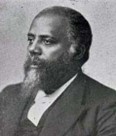-
Black History Month in Washington Wilkes County
Cathy PeabodySunday, February 2, 2025
Washington and Wilkes County, Ga. are rich in history and heritage, with notable African American leaders and ancestors who left their marks not only on local culture but also on Georgia and American history.
Prominent African Americans in Washington-Wilkes
Austin Dabney (c. 1765–1830)
Austin Dabney was an enslaved African American who fought against the British in the American Revolutionary War. Born into slavery in North Carolina, he was relocated when his enslaver Richard Aycock moved to Wilkes County, Georgia. When Aycock was called to join the Patriot forces, he sent Dabney to fight against the British army in his place.
Dabney became a soldier under Lieutenant Colonel Elijah Clarke and fought at the Battle of Kettle Creek, where he was shot and sustained a crippling injury. After the war and after his owner’s death, Dabney was emancipated and on August 14, 1786, became the only African American to be granted land by the state of Georgia in recognition of his bravery and American Revolutionary War service.
Bishop Wesley John Gaines (1840-1912)

Bishop Wesley John Gaines was born to enslaved parents Louisa and William Gaines in 1840 in Wilkes County, Georgia. His father was a member of the Methodist Episcopal Church (MEC), and Gaines was named after the founder of Methodism John Wesley. As a sickly child and often bedridden, Gaines taught himself to read and at a young age was able to read the Bible, igniting a passionate faith and a career in leadership for the AME Church, where he was ordained an elder in the African Methodist (AME) Church in 1867.
Gaines later became the second pastor of Big Bethel AME in Atlanta and grew the church into the largest Black congregation in the south. At the AME North Georgia Annual Conference, held at Big Bethel in January of 1881, Gaines called for a resolution to establish an institution for higher learning to promote the moral, spiritual and intellectual growth of African American students. The Conference concurred and in May of 1885, the State of Georgia granted a charter to Morris Brown College of the AME Church. Morris Brown College opened on October 15, 1885, just 20 years after Abraham Lincoln signed the Emancipation Proclamation. Morris Brown was the first African American educational institution in Georgia, named in honor of the second Bishop of the AME Church.
Bishop Wesley Gaines and his brother William Gaines (1824-1865) were involved in the foundation of Jackson Chapel AME in Washington, Ga., as well as other AME churches throughout the south.
William Gaines was one of twenty Black church leaders, along with Garrison Frazier, Ulysses L. Houston and James D. Lynch, who met with Major General William Tecumseh Sherman and Secretary of War Edwin Stanton in Savannah about three months before the end of the Civil War. This meeting, later called “Savannah Colloquy” led to Sherman’s Special Field Orders No. 15 and the famous Forty acres and a mule land allotment.
Tell a Friend
-
Make History Here
